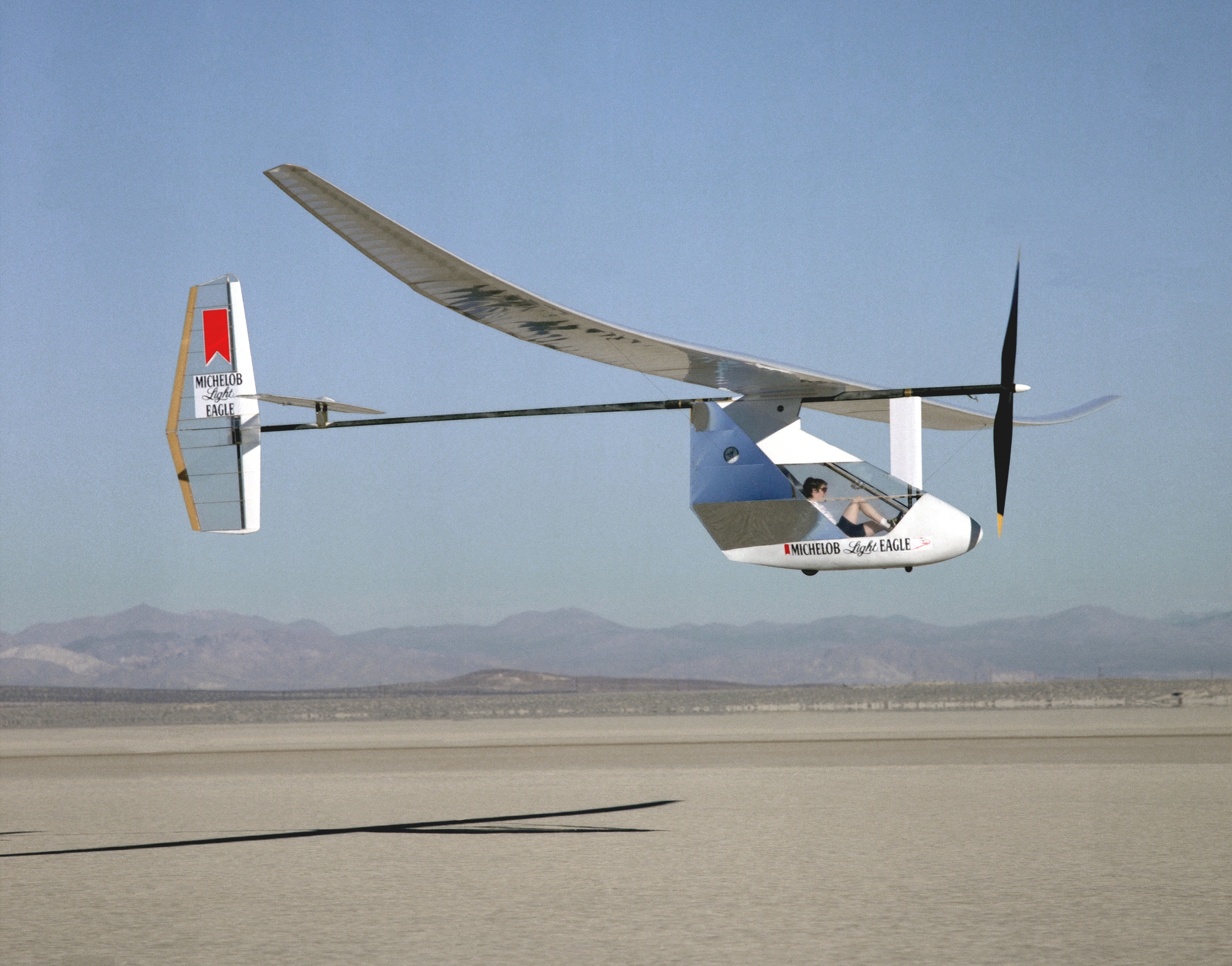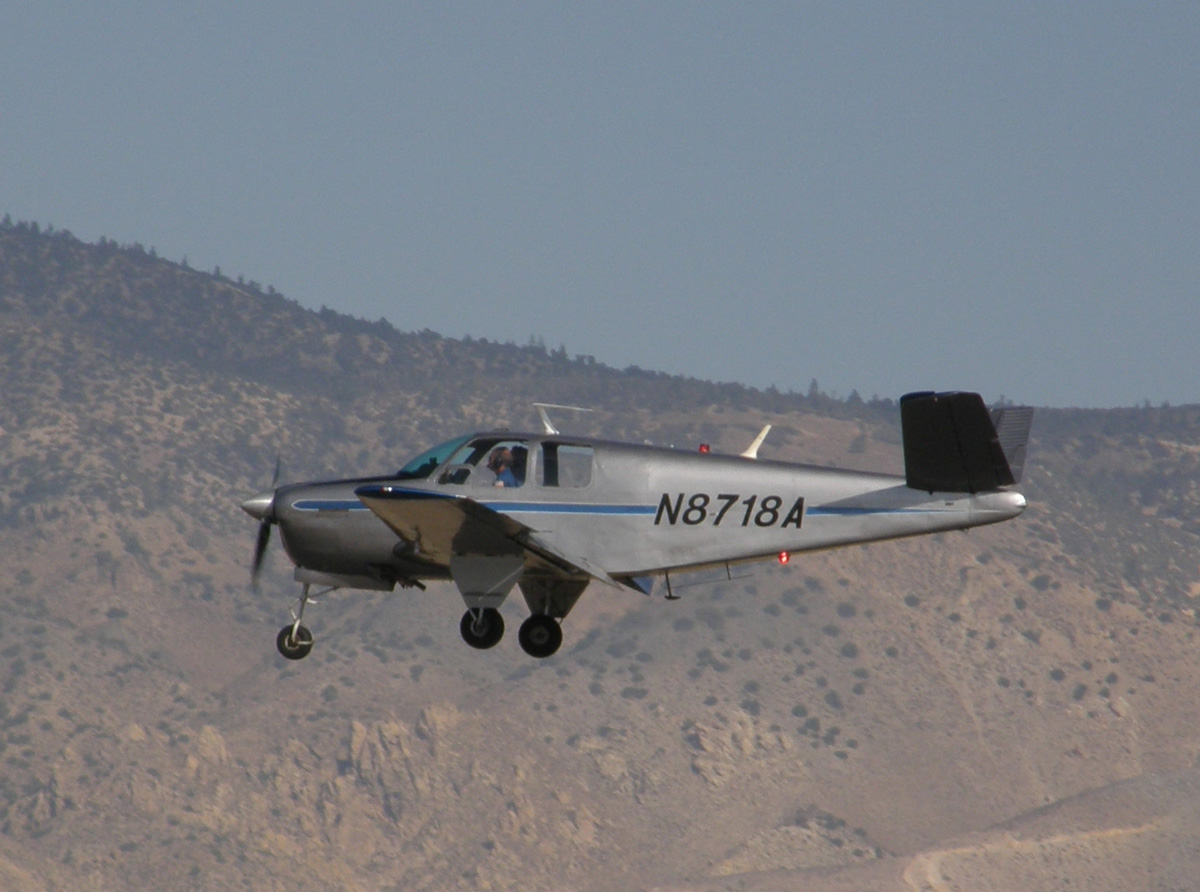|
Wright Micron
The ''Micron'' was the second of two human-powered aircraft designed and built by Peter Wright, an engineer from Melton Mowbray, England. Wright had previously designed and built the Wright MPA Mk 1, which first flew in 1972. The low wing loading of that design affected the flight opportunities which could be made. The design of his second human-powered aircraft, the ''Micron'', began in 1974 with the intent that it be robust and practical; to this end, it had a relatively high wing loading, thereby increasing flight opportunities. It was also intended to be easily assembled and transportable in a glider trailer. The ''Micron'' was of conventional configuration. It was a low-wing monoplane, with a very streamlined fuselage and a V-tail empennage. The pilot sat in a recumbent position, pedalling a set of bicycle pedals, and powering a pusher propeller mounted on a pylon located near the front of the fuselage. Power transmission was by a cable/roller drive. The craft made ex ... [...More Info...] [...Related Items...] OR: [Wikipedia] [Google] [Baidu] |
Human-powered Aircraft
A human-powered aircraft (HPA) is an aircraft belonging to the class of vehicles known as human-powered transport. Human-powered aircraft have been successfully flown over considerable distances. However, they are still primarily constructed as engineering challenges rather than for any kind of recreational or utilitarian purpose. History Early attempts at human-powered flight were unsuccessful because of the difficulty of achieving the high power-to-weight ratio. Prototypes often used ornithopter principles which were not only too heavy to meet this requirement but aerodynamically unsatisfactory. First attempts In 1904, Scientific American published an article and a photograph of a bicycle plane built by Steward Winslow of Riparia, Washington. He attempted to fly his plane on 30 July 1904, but one of the wheels failed. An early human-powered aircraft was the Gerhardt Cycleplane, developed by W. Frederick Gerhardt at McCook Field in Dayton, Ohio in 1923. The aircraft h ... [...More Info...] [...Related Items...] OR: [Wikipedia] [Google] [Baidu] |
MacCready Gossamer Condor
The MacCready ''Gossamer Condor'' was the first human-powered aircraft capable of controlled and sustained flight; as such, it won the Kremer prize in 1977. Its design was led by Paul MacCready of AeroVironment, Inc. Design and development The Kremer Prize had been set up in 1959 by Henry Kremer, a British industrialist, and offered £50,000 in prize money to the first group that could fly a human-powered aircraft over a figure-eight course covering a total of one mile (1.6 kilometers). The course also included a ten-foot pole that the aircraft had to fly over at the start and at the end. Early attempts to build human-powered aircraft had focused on wooden designs, which proved too heavy. Very early attempts – notably the ' and ''Pedaliante'' – used catapult launches. In 1961, Southampton University's Man Powered Aircraft SUMPAC took to the air at Lasham Airfield on 9 November, piloted by Derek Piggott, achieving a maximum flight of 650 metres. One week later, on 16 N ... [...More Info...] [...Related Items...] OR: [Wikipedia] [Google] [Baidu] |
V-tail Aircraft
The V-tail or ''Vee-tail'' (sometimes called a butterfly tail or Rudlicki's V-tailGudmundsson S. (2013). "General Aviation Aircraft Design: Applied Methods and Procedures" (Reprint). Butterworth-Heinemann. p. 489. , 9780123973290) of an aircraft is an unconventional arrangement of the tail control surfaces that replaces the traditional fin and horizontal surfaces with two surfaces set in a V-shaped configuration. It is not widely used in aircraft design. The aft edge of each twin surface is a hinged control surface called a ruddervator, which combines the functions of both a rudder and elevator. The V-tail was invented in 1930 by Polish engineer Jerzy Rudlicki and was tested for the first time on the Hanriot H-28 trainer aircraft, modified by a Polish aerospace manufacturer Plage and Laśkiewicz in the summer of 1931. Variants The X-shaped tail surfaces of the experimental Lockheed XFV were essentially a V tail that extended both above and below the fuselage. Conventional T ... [...More Info...] [...Related Items...] OR: [Wikipedia] [Google] [Baidu] |
Pusher Aircraft
In an aircraft with a pusher configuration (as opposed to a tractor configuration), the propeller(s) are mounted behind their respective engine(s). Since a pusher propeller is mounted behind the engine, the drive shaft is in compression in normal operation. Pusher configuration describes this specific (propeller or ducted fan) thrust device attached to a craft, either aerostat (airship) or aerodyne (aircraft, WIG, paramotor, rotorcraft) or others types such as hovercraft, airboat and propeller-driven snowmobiles. "Pusher configuration" also describes the layout of a fixed-wing aircraft in which the thrust device has a pusher configuration. This kind of aircraft is commonly called a pusher. Pushers have been designed and built in many different layouts, some of them quite radical. History The rubber-powered "Planophore", designed by Alphonse Pénaud in 1871, was an early successful model aircraft with a pusher propeller. Many early aircraft (especially biplanes) were ... [...More Info...] [...Related Items...] OR: [Wikipedia] [Google] [Baidu] |
Low-wing Aircraft
A monoplane is a fixed-wing aircraft configuration with a single mainplane, in contrast to a biplane or other types of multiplanes, which have multiple planes. A monoplane has inherently the highest efficiency and lowest drag of any wing configuration and is the simplest to build. However, during the early years of flight, these advantages were offset by its greater weight and lower manoeuvrability, making it relatively rare until the 1930s. Since then, the monoplane has been the most common form for a fixed-wing aircraft. Characteristics Support and weight The inherent efficiency of the monoplane is best achieved in the cantilever wing, which carries all structural forces internally. However, to fly at practical speeds the wing must be made thin, which requires a heavy structure to make it strong and stiff enough. External bracing can be used to improve structural efficiency, reducing weight and cost. For a wing of a given size, the weight reduction allows it to fly slower ... [...More Info...] [...Related Items...] OR: [Wikipedia] [Google] [Baidu] |
List Of Human-powered Aircraft
This is a list of human-powered aircraft A human-powered aircraft (HPA) is an aircraft belonging to the class of vehicles known as human-powered transport. Human-powered aircraft have been successfully flown over considerable distances. However, they are still primarily constructed a ... by date. See also * History of human-powered aircraft References Further reading * External links Chris Roper's online book ''Human Powered Flying''Prop designer Vélair – Yuri human-powered helicopter – YouTube video [...More Info...] [...Related Items...] OR: [Wikipedia] [Google] [Baidu] |
Paxton Man-powered Aircraft
The Paxton man-powered aircraft was the project of architect Tony Paxton, to create a compact human-powered aircraft, suitable for sports flying. It was a low-wing monoplane, but mounted on top of a tall undercarriage 6 ft off the ground. The airframe was constructed of metal tubing, with extensive use of styrofoam in order to create the wing ribs and fuselage formers. The wings were of constant chord and made use of the thick-sectioned high-lift GU25-5(11)8 aerofoil. The wings were also wire braced, and fitted with tip plates at each wingtip. Control was very similar to that of the Weybridge ''Dumbo'' machine; the cruciform tail featured movable control surfaces on both fins and the tailplanes, with lateral control being achieved by rotating each wing, in its entirety, around the spar. The pilot sat in the open air, in a reclined position, and powered a 2-bladed pusher propeller via a bevel-geared drive system. Initial tests with the aircraft resulted in a failure o ... [...More Info...] [...Related Items...] OR: [Wikipedia] [Google] [Baidu] |
MacCready Gossamer Albatross
The ''Gossamer Albatross'' is a human-powered aircraft built by American aeronautical engineer Dr Paul B MacCready's company AeroVironment. On June 12, 1979, it completed a successful crossing of the English Channel to win the second Kremer prize worth £100,000 (). Design and development The aircraft was designed and built by a team led by Paul B. MacCready, a noted American aeronautics engineer, designer, and world soaring champion. ''Gossamer Albatross'' was his second human-powered aircraft, the first being the ''Gossamer Condor'', which had won the first Kremer prize on August 23, 1977, by completing a -long figure-eight course. The second Kremer challenge was then announced as a flight across the English Channel recalling Louis Blériot's crossing of 1909. The aircraft is of " canard" configuration, using a large horizontal stabilizer forward of the wing in a manner similar to the Wright brothers' successful ''Wright Flyer'' aircraft and powered using pedals to drive a ... [...More Info...] [...Related Items...] OR: [Wikipedia] [Google] [Baidu] |
Melton Mowbray
Melton Mowbray () is a town in Leicestershire, England, north-east of Leicester, and south-east of Nottingham. It lies on the River Eye, known below Melton as the Wreake. The town had a population 27,670 in 2019. The town is sometimes promoted as Britain's "Rural Capital of Food", it is the home of the Melton Mowbray pork pie and is the location of one of six licensed makers of Stilton cheese. History Toponymy The name comes from the early English word Medeltone – meaning "Middletown surrounded by small hamlets" (as do Milton and Middleton). Mowbray is the Norman family name of early Lords of the Manor – namely Robert de Mowbray. Early history In and around Melton, there are 28 scheduled ancient monuments, some 705 buildings of special architectural or historical interest, 16 sites of special scientific interest, and several deserted village sites. Its industrial archaeology includes the Grantham Canal and remains of the Melton Mowbray Navigation. Windmill sites and ... [...More Info...] [...Related Items...] OR: [Wikipedia] [Google] [Baidu] |
Malliga 1
The Malliga 1 human powered aircraft was the project of Horst Josef Malliga. It is thought that it was the first successful Continental European human-powered aircraft. Design work began in August 1966, with the first flight taking place in September 1967. The aircraft was a low-wing monoplane, with a pod and boom configuration. The pilot sat in a recumbent position, and powered a two bladed pusher propeller, located behind a streamlined nacelle. Twin booms supported twin fins, with an all-flying tailplane located between them. Constructed from aluminium tubing and polystyrene, with plastic film covering. The Malliga 1 had a constant-chord wingplan, and spanned 20.00 m (65 ft 7in). As originally designed, the tailfins did not incorporate rudders, and directional control was made via two fins located outboard and underneath the wing. Lateral control was obtained by wingtip ailerons. With this configuration, and under human-power alone, flights of up to 150 m (487.50 ... [...More Info...] [...Related Items...] OR: [Wikipedia] [Google] [Baidu] |
HMPAC Puffin
The HMPAC Puffin was a British man-powered aircraft designed by a team headed by John Wimpenny, an aerodynamicist at the de Havilland Aircraft Company. It was built by the Hatfield Man Powered Aircraft Club (HMPAC) on the company's premises in Hatfield, Hertfordshire. On 2 May 1962, Wimpenny, aged 39, piloted the Puffin at the Hatfield Aerodrome, pedalling to power the propeller, achieving a flight distance of , a world record which was to stand for ten years. The Puffin had a wingspan of . Puffin II An improved version of the Puffin was developed and built in 1965 as the HMPAC Puffin II. First flown on 27 August 1965, the Puffin II utilized the transmission components of the Puffin I in a completely new airframe. After it had been damaged, the Puffin II airframe was given to Liverpool University, who used it to build the Liverpuffin. Specifications See also * SUMPAC * List of human-powered aircraft References * Further reading *{{cite book, last1=Reay, first1=D. A., ... [...More Info...] [...Related Items...] OR: [Wikipedia] [Google] [Baidu] |




